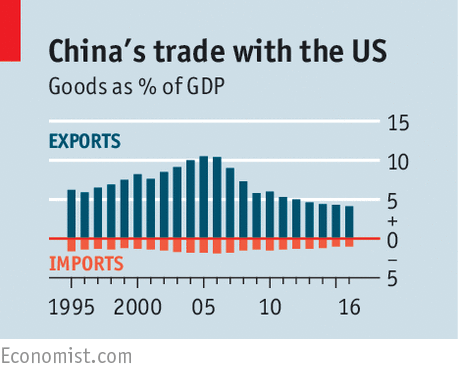How Trump can press China without resorting to a trade war
What a constructive American approach to trade with China would look like

It is not yet clear whether Donald Trump’s belligerence is simply a ploy designed to win trade concessions from China and others, or whether he is prepared to foment economic warfare—and worse—if he is thwarted. But no relationship matters more than that between the world’s biggest and second-biggest economies. The shape of a new economic order, and much besides, will be determined largely by how Mr Trump and Mr Xi deal with each other. There is plenty to fear.
Mr Trump has been known to vacillate over great swathes of policy, but on trade he has been consistent in his belief that America gets a bad deal. In the first days of his presidency, he pulled America out of the Trans-Pacific Partnership (TPP), an agreement designed to knit together economies in Asia and the Americas; threatened a big border tax on American firms that moved jobs abroad; and affirmed his intention to renegotiate NAFTA, a North American free-trade deal.
Unlike some of these anti-trade threats, the desire to act against China is at least understandable. Mr Xi professes to support open markets, but runs an economy built on mercantilist pillars. Favoured Chinese firms benefit from subsidised financing and rent. China keeps tracts of its economy off-limits to foreign investors as it pumps money towards its own champions: it has, for example, earmarked $150bn to nurture its semiconductor industry. Those who are allowed in are often required to hand over their intellectual property.
As easy as 1, 2, 3
If
Mr Trump is to deal with China wisely, he should follow three rules.
The first is to resist the impulse to mix trade politics and
geopolitics. America’s new president seems to think he can increase his
bargaining power by hitching trade to China’s territorial claims in the
South China Sea (see article)
and the status of Taiwan. Yet Mr Trump is not the only one with a
nationalist constituency to please. For Mr Xi, Taiwan is non-negotiable
and the South China Sea a “core” interest.The second is to focus on real abuses and avoid self-harm. During the campaign, Mr Trump pledged to designate China a currency manipulator. Although China still manipulates the currency, it does so to stop the yuan from falling too quickly, rather than weakening it to help exporters. Blanket tariffs of the sort Mr Trump has threatened would weigh most heavily on the poorest Americans. American exports to China are relatively concentrated in areas such as aeroplanes and farm products. That leaves the country vulnerable to immediate retaliation by Chinese regulators (see article).
Last, Mr Trump should call Mr Xi’s bluff about being a model citizen of global trade by using the system’s own institutions to prosecute Chinese abuses. The international-trade bureaucracy works fairly well. The Obama administration brought 16 complaints against China at the World Trade Organisation (WTO), and did not lose a case.
It is true that this course will not come naturally to an impatient president who relishes conflict. The WTO intentionally tries to take the drama out of trade politics. A case can take several years to see through. Too much extra litigation risks overwhelming its dispute-settlement apparatus. The pay-off, however, is that this reduces the chances of an all-out conflict that would frustrate Mr Trump’s overriding goal of healthy economic growth in America.
The irony is that, by withdrawing from the TPP—a trade agreement which, though it currently excludes China, might one day have constrained its ability to pollute and subsidise state-owned enterprises—Mr Trump has immediately turned his back on the most promising way to change the economy he seems most worried about. If he really wanted to shake up the global trade system for the better, Mr Trump would resurrect some of the TPP’s provisions and use them as the basis for a grand bargain with China and other countries. That would be a beautiful deal. Alas, it also seems highly unlikely.
No comments:
Post a Comment